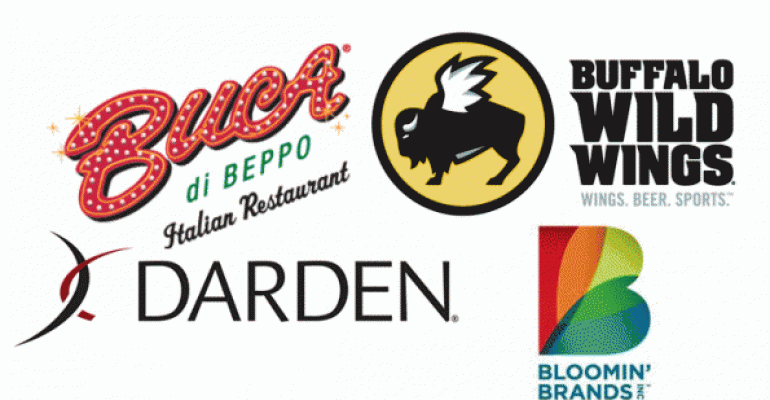In recent years, more businesses have started holding meetings and celebrations with a catered meal at the office, rather than at a restaurant.
That’s a problem for a casual-dining chain like Buca di Beppo, which gets a lot of business from companies looking for a place to hold events. So three years ago, the family-style Italian concept began working with an online catering marketplace called ezCater in a bid to go after in-office orders.
The move worked. Catering has been up in the double digits in each of the past three years, providing Buca di Beppo with a new sales lever at a time when business isn’t exactly booming in the casual-dining segment.
“If you look at some of our locations, there are days when we have $5,000 or $6,000 in revenue before we open the doors,” said Trish Giordano, vice president of sales and marketing for 92-unit Buca di Beppo. “We already have staff in the building. Most orders are out between 10:30 and 12:30, so it doesn’t interfere with lunch business.”
While Buca di Beppo has continued to grow sales from catering, getting those sales is more work now than ever.
“It’s much more competitive this year than ever,” Giordano said. “It’s really important the operations team execute every order with service as if they’re dining in our own restaurant.”
Buca di Beppo isn’t the only chain looking to catering to generate sales. Casual-dining chains have been aggressively promoting other areas of business in recent years as traffic continues a decade-long slowdown. Operators are marketing catering, lunch and to-go offers, all in an effort to win back lost sales.
Same-store traffic at casual-dining restaurants has fallen nearly every month since 2012, according to the MillerPulse survey.
Casual dining’s share of industry traffic has fallen 20 percent since 2007, according to BMO Capital Markets analyst Andrew Strelzik. In 2007, 10 percent of transactions were at a casual-dining restaurant. By 2015, that number had fallen to 8 percent.
The decline has chains and executives scrambling for answers.
“Everyone is looking for additional channels,” Giordano said.
Buffalo Wild Wings Inc. is among the more aggressive chains when it comes to pulling new sales levers.
The Minneapolis-based chicken-wing specialist has traditionally relied on parties of diners lingering over sports events. But this year it has worked harder to generate lunch and to-go business.
Earlier this year, Buffalo Wild Wings introduced a Fast Break Lunch, which guarantees a meal ordered from a certain selection of items to be delivered within 15 minutes.
“We don’t focus on turning tables,” Todd Kronebusch, Buffalo Wild Wings vice president of guest experience and innovation, told Nation’s Restaurant News earlier this year. “We don’t focus on driving customers in and out of the restaurant like casual dining. But we compete in a different space at lunch. At lunch it’s about one thing: coming in, getting a great meal and getting back to work.”
Executives said during the company’s third-quarter earnings call in October that they were pleased with the results of the lunch program so far. They also described efforts to increase to-go sales by beefing up the chain’s counter service. Currently, 16 percent of Buffalo Wild Wings’ sales are takeout. Delivery is also in test.
Several other casual-dining chains are exploring delivery in a bid to increase takeout orders. Bravo Brio Restaurant Group Inc. and Applebee’s are among those testing delivery. And Outback Steakhouse owner Bloomin’ Brands Inc. is exploring strategies it can use to increase takeout business.
“People want convenience and they want [casual-dining] food quality, but not always in the restaurant,” Bloomin’ Brands CEO Liz Smith said during the company’s third-quarter earnings call, saying that it is a “sizable” potential sales layer.
Olive Garden’s promotion of to-go orders has had real results. To-go sales increased 20 percent in the first quarter of 2017. Same-store sales also increased 2 percent, and the Italian chain outperformed the casual-dining segment during the period by 410 basis points. Take-out now comprises 11 percent of the chain’s business.
That includes catering, which the chain will now deliver for large orders of more than $125.
“For some families, that’s a family meal, if it’s a large family,” Darden CEO Gene Lee said during a first-quarter earnings call. “So it’s being used for all sorts of occasions.”
At Buca di Beppo, the chain hasn’t just focused on catering. When Earl Enterprises, the owner of Planet Hollywood Inc., acquired the chain in 2008, “We were surprised they were closed for lunch at many locations,” vice president of sales and marketing Trish Giordano said. “We made the decision to open for lunch. It was an opportunity to grow that business segment.”
Buca di Beppo has sales managers for each restaurant who target businesses in a bid to get them to hold events at the chain’s restaurants.
“We saw an immediate return,” Giordano said.
Large parties make more sense for Buca di Beppo than smaller parties because the dishes are large and shareable. And large parties are more profitable, while bringing in customers who might not otherwise visit the chain.
“It’s a lucrative business,” Giordano said. “When you’re buying food for the entire office, it’s a larger order typically. Every type of business has potential for customers. Focusing just on a party of two or three doesn’t make sense for Buca.”
Contact Jonathan Maze at [email protected]
Follow him on Twitter at @jonathanmaze




